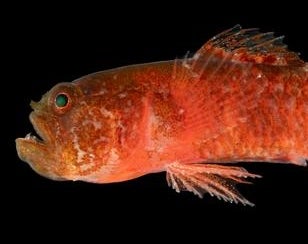New ‘Grumpy’ fish species discovered in Red Sea
The rare red fish looks perpetually unhappy and sports some serious canines

Researchers have discovered a new fish in Saudi Arabia that looks to be a little crabby.
The Grumpy dwarfgoby, known by scientists as Sueviota aethon, was first found off Saudi Arabia’s Farsan banks: an area of reefs that line the Red Sea.
The fish were swimming in small “caves” and under overhangs, at depths between 33 and 174 feet beneath surface waters. Later, more specimens were seen near the Makkah Province village of Thuwal.
At a length of less than two centimeters, the rare fish is characterized by its large canine teeth and intimidating expression. Some were dark red and others were yellowish-orange and white, with dark black pupils and iridescent golden rings that surround them.
Their red coloration helps them to blend into their habitat: the walls of the reefs, which are covered in red algae. The fish use their large canines to seize tiny prey.

The discovery was made by scientists at King Abdullah University of Science and Technology and the University of Washington.
Initially, they believed they had rediscovered the known fiery dwarfgoby, which was initially found in the early 1970s. But, then they took a closer look. Their findings were published last week in the journal ZooKeys.
“I imagine in its own tiny world, it is a fearsome predator. Its grumpy expression and large canines certainly make it look the part, despite its small size,” study co-author Lucía Pombo-Ayora said in a statement.
The region, known for its high levels of species that do not occur anywhere else in the world, has been disturbed by climate change in recent years.

Around 94 percent of the ocean’s surface experienced at least one marine heat wave in 2023. Under the pressure of marine heat, corals can drive out the algae that sustain their ecosystems, turning them white and susceptible to disease.
Rising ocean temperatures combined with increasing acidification have created inhospitable environments for coral. Increasing ocean acidity - as the ocean absorbs more carbon dioxide from the atmosphere - causes reefs to dissolve, as well as other organisms’ shells and skeletons also made from calcium carbonate.
Coral structures, themselves, are animals and comprise thousands of tiny creatures called polyps. Those polyps secrete a hard outer skeleton of calcium carbonate.
The Red Sea has seen widespread coral bleaching events and coral deaths. Of course, there are other reasons for coral bleaching, like pollution, low tides, and too much sunlight.

Finding the grumpy dwarfgoby, they believe, only increases the urgency of continuous conservation and research in the area.
“The ongoing discovery of distinctive new species like this grumpy dwarfgoby shows how much biodiversity remains undiscovered in the Red Sea,” Viktor Nunes Peinemann said. Peinemann first found the fish during a diving expedition to check out the diversity in the reef. “This is concerning given the recent environmental changes in the region. In some cases, species could go extinct before we even describe them.”
The Independent will be revealing its Climate100 List in September and hosting an event in New York, which can be attended online.
Join our commenting forum
Join thought-provoking conversations, follow other Independent readers and see their replies
0Comments